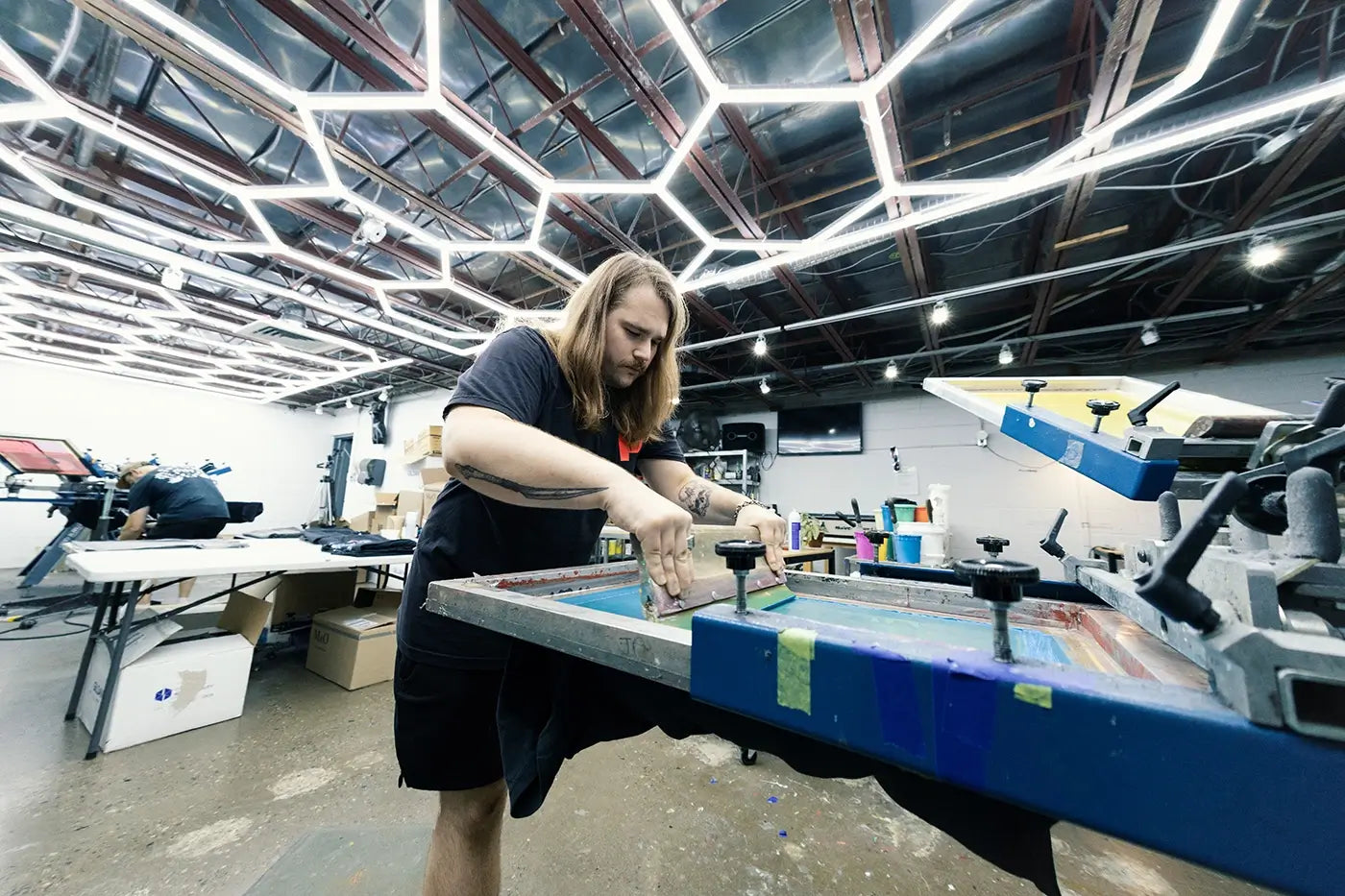Budget-Friendly T-Shirt Printing for Startups
Screen Printing Uncovered: Every Little Thing You Required to Learn About T-Shirt and Garment Printing Strategies
Display printing is an interesting method that combines art with technique, offering endless possibilities for creative thinking. All set to check out the necessary aspects that make screen publishing an art type?
The Fundamentals of Screen Printing: Just How It Works
When you dive into display printing, you'll discover it's both an art and a science. At its core, screen printing entails developing a pattern, or screen, that permits ink to pass with just in certain areas.
Placement the screen over the fabric, after that utilize a squeegee to push ink with the display onto the garment. Each step is crucial, and mastering them will certainly boost your screen printing skills, transforming simple garments into special, meaningful items.
Types of Screen Printing Strategies
Once you understand the essentials of display printing, it's time to explore the different techniques that can boost your layouts. One prominent method is conventional display printing, where ink is pushed via a stenciled display. This strategy is wonderful for vibrant, dynamic shades. After that there's water-based ink printing, which uses a softer feel and is eco-friendly, yet it needs a various approach to curing.
If you're aiming for fine details, take into consideration discharge printing. This strategy removes dye from the material, leaving a soft, vintage look. One more choice is plastisol printing, understood for its resilience and vibrant colors, making it a favorite for many brands. Experiment with halftone printing to produce gradient results and complex designs. Each strategy has its special beauty, so do not think twice to try them out to locate what fits your style best!
Necessary Tools for Display Printing
To achieve sensational outcomes in screen printing, having the appropriate tools is essential. You'll require a tough screen printing structure, which holds the mesh that moves your layout onto the garment. Next, spend in top notch squeegees; these are important for using ink evenly throughout the display.
Picking the Right Inks and Materials
When picking inks and materials for display printing, you need to consider the kind of ink that works best for your job. Think of fabric compatibility to assure your designs look last and excellent long. Explore environmentally friendly ink choices to make your printing process much more sustainable.
Kinds of Display Inks
Picking the right screen ink is important for accomplishing vivid, resilient prints that satisfy your task's demands. There are a number of types of display inks to check out. Specialty inks, such as glow-in-the-dark or metallic, can include special results to your designs.

Fabric Compatibility Considerations
Recognizing material compatibility is vital for achieving top notch screen prints, especially because different products respond distinctly to different inks. When choosing inks, take into consideration the material type-- cotton, polyester, or blends. For cotton, water-based inks work well, supplying soft qualities and breathability. Polyester, on the other hand, frequently calls for plastisol inks for better attachment and vibrant shades. You might require to use a mix of both kinds if you're publishing on blends. Constantly evaluate your inks on sample fabric to guarantee they stick correctly and preserve shade stability. In addition, maintain in mind that textile weight and structure can affect the last outcome, so picking the right ink and material combo is vital for your task's success.
Eco-Friendly Ink Options
Environmentally friendly inks are becoming a preferred choice for display printers who want to lessen their environmental effect while keeping quality. When selecting inks, take into consideration water-based inks, which are much less hazardous and much easier to clean up contrasted to typical solvents.
In addition, search for inks made from eco-friendly sources, such as soy or vegetable-based choices. By choosing the best inks and materials, you'll not just create spectacular styles but likewise add to a much more sustainable printing process. Make the switch, and your prints will certainly mirror your commitment to the atmosphere!
Preparing Your Layout for Display Printing

File Style Requirements
To guarantee your layout looks vibrant and sharp on fabric, you'll require to pay close attention to submit format demands for display printing. Start with vector data like AI or EPS, as they can be scaled without losing top quality. If you make use of raster pictures, decide for high-resolution data, such as TIFF or PNG, ideally at 300 DPI. Prevent making use of JPEGs, as they can lose clearness when resized. Also, make certain your style has a clear background to avoid undesirable white silk screen printing sides on your prints. Ultimately, keep shade settings in mind; CMYK is standard for display printing, so convert your RGB develops appropriately. By complying with these standards, you'll establish your art work up for an effective print.
Color Separation Strategies
Color separation is an essential action in preparing your design for screen printing, and understanding it can substantially boost your print quality. You'll need to damage your layout right into specific shades, as each color requires a different screen throughout printing. This accuracy not just guarantees precise shade depiction but also simplifies the printing process.
Resolution and Size
Accomplishing the very best cause screen printing starts with ensuring your design has the right resolution and size. Ideally, your art work should be at the very least 300 DPI (dots per inch) for sharp, clear prints. If you utilize reduced resolution, your end product may look amateur and pixelated.
When it pertains to size, consider the measurements of your print area. Style your artwork to match the last print size, ideally developing it in the actual dimensions you'll be publishing. This means, you'll avoid any unforeseen scaling concerns.
Constantly inspect your layout in both vector and raster layouts. Vector graphics can be scaled without shedding high quality, making them perfect for display printing. Preparing correctly will assure your style looks outstanding on every garment!
Step-by-Step Screen Printing Process
Screen printing is a vibrant process that allows you to create lively styles on various surface areas. To get begun, you'll need a display, solution, and your chosen ink.
Put ink onto the screen and make use of a squeegee to press the ink via the stencil onto the textile. Raise the screen carefully and allow the print dry. You have actually effectively screen published your design.
Tips for Effective Display Printing Projects
While you're diving right into your display printing projects, keep in mind that preparation is vital to success. Beginning by collecting all your materials-- inks, screens, garments, and mops. A tidy work space aids protect against unwanted errors, so clean prior to you begin.
Following, validate your art work is high-resolution and properly sized for your garment. Evaluate your display for proper direct exposure and clean it thoroughly to stay clear of spots. When mixing your inks, adhere to the producer's guidelines to achieve the best uniformity.
Throughout printing, apply also pressure with your squeegee for regular results. Don't rush; take your time to verify each print satisfies your criteria. After printing, let your garments dry totally prior to dealing with or packaging them.
Finally, constantly keep a sample of your benefit future referral. By doing this, you can examine your progress and enhance your strategies with time. Pleased printing!

Regularly Asked Concerns
For how long Does It Require To Establish up a Screen Printing Job?
Establishing a display printing check my source work commonly takes about 30 mins to an hour. You'll prepare the displays, mix inks, and change journalism. The moment varies based upon intricacy and experience, so remain arranged!
Can I Publish on Various Material Enters Utilizing the Exact Same Method?
Yes, you can publish on various material types using the very same technique, yet you'll require to readjust your inks and settings. Some materials take in ink differently, so trying out warranties the most effective results for each product.
What Prevail Blunders to Avoid in Screen Printing?
When display printing, prevent common mistakes like making use of the incorrect ink, ignoring proper direct exposure times, or missing pre-press checks. Constantly evaluate your setup and keep clean displays to guarantee top quality outcomes each time.
How Can I Effectively Clean and Keep My Screen Printing Equipment?
To effectively clean and keep your screen printing tools, you must consistently wash displays with suitable solvents, check mops for wear, and ensure all tools are saved dust-free and completely dry. Uniformity boosts and prevents expensive repairs efficiency.
Is Display Printing Eco-friendly Compared to Other Methods?
Display printing can be more environmentally pleasant than other methods, particularly if you use water-based inks and eco-conscious products. By choosing sustainable products and practices, you lower waste and minimize your influence on the planet.
Display Printing Uncovered: Whatever You Required to Know About T-Shirt and Garment Printing Techniques
At its core, display printing entails producing a pattern, or screen, that allows ink to pass via only in specific areas. Position the screen over the fabric, then make use of a squeegee to push ink through the screen onto the garment. One popular technique is conventional screen printing, where ink is pressed via a stenciled screen.When choosing inks and products for screen printing, you require to take right into account the type of ink that functions best for your job.